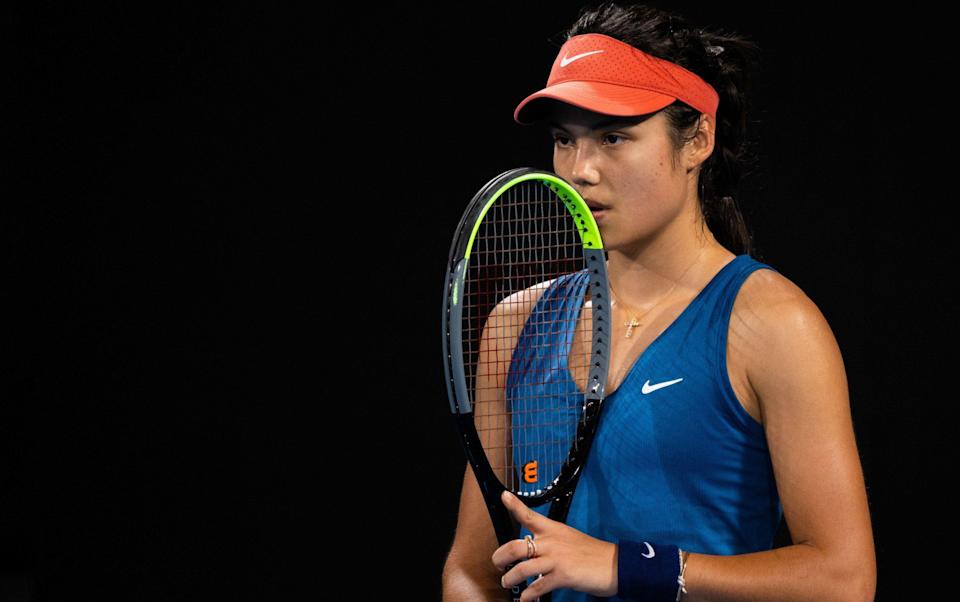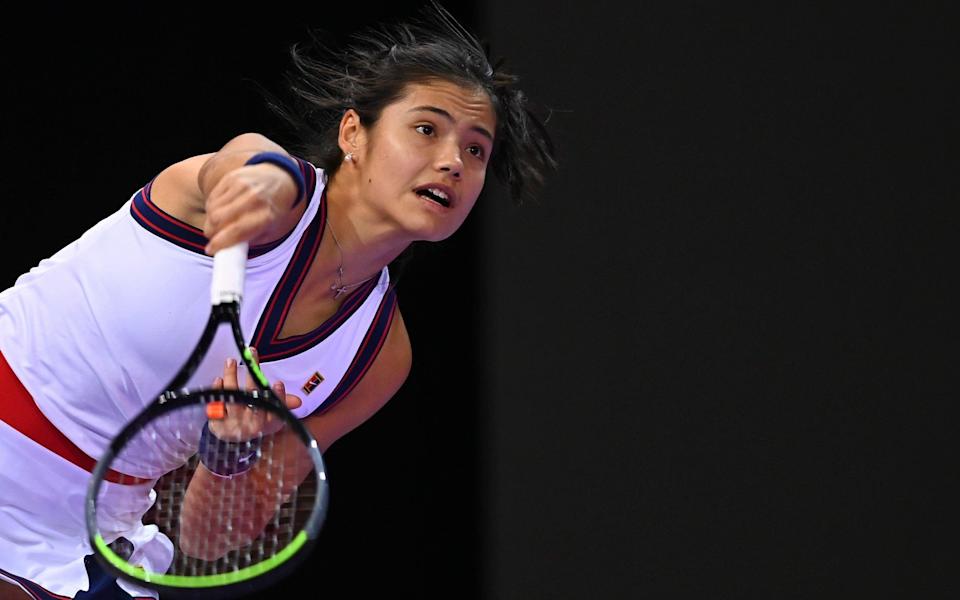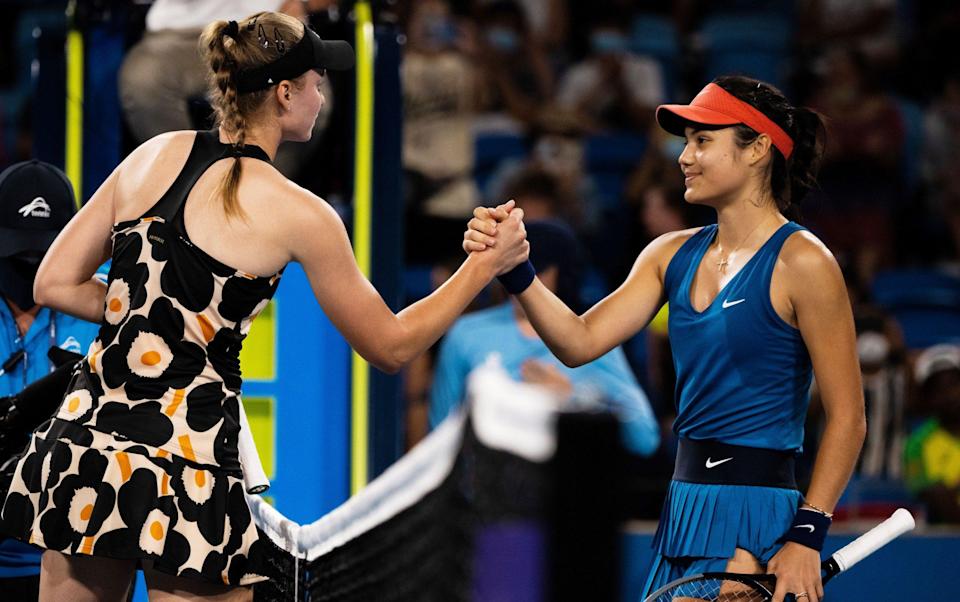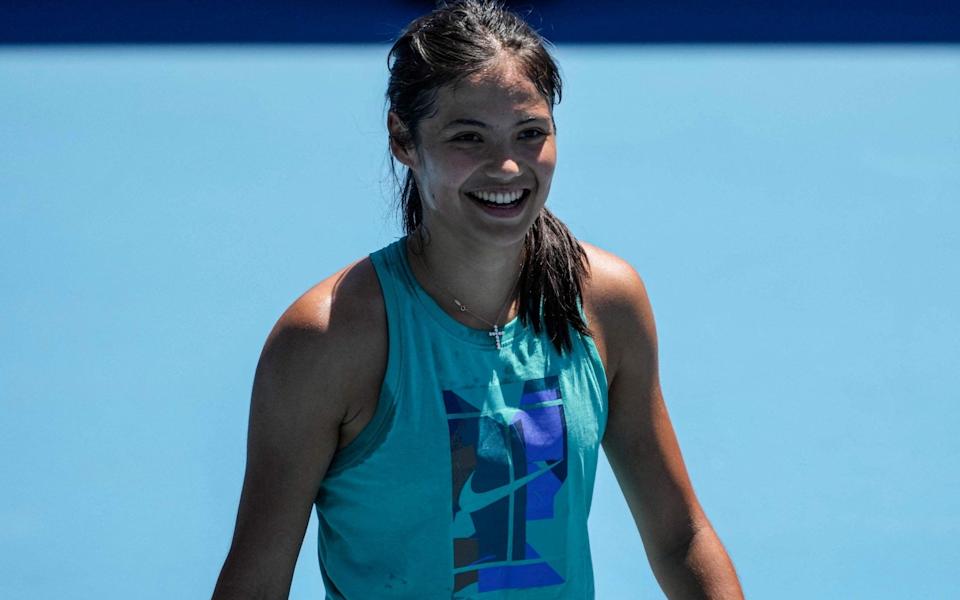
Emma Raducanu is looking to bounce back from indifferent form since she won the US Open last September. Here, Uche Amako looks at four lessons ahead of her Australian Open match this week.
1: Flimsy second serve
Aliaksandra Sasnovich defeated Emma Raducanu 6-2, 6-4 – Indian Wells – October 9 2021
Raducanu arrived in California without a coach having dispensed with the services of Andrew Richardson a few weeks prior. Sasnovich is a tricky customer, who varies the speed of her shots well and makes great use of angles to get opponents on the run and on this occasion, Raducanu didn’t adapt quick enough to the situation. Better game management will come with more matches and time on the court facing different players.
Here, Sasnovich took full advantage of a recurring issue for Raducanu – a below-par second serve. The Briton won just 23.8 per cent of points on her second serve as Sasnovich got the ball back in play regularly and with depth, to gain the upper hand in points.
Confidence can quickly disappear when the serve is not working well and it was clear Raducanu was getting frustrated by it. To compound the issue, Raducanu made 30 unforced errors which is not ideal when the other areas of your game are not firing.
The other disappointing detail for Raducanu will have been the quality of her returns, which were formidable throughout the US Open.
Raducanu is an excellent returner, with great timing and reactions but in nine return games against Sasnovich, she only won 41 per cent of points off the Belarussian’s serve. She can occasionally go for high-risk shots off the return when simply getting the ball back in play to set up the point would be more pertinent.
2: Too many unforced errors
Marta Kostyuk defeated Emma Raducanu 6-2, 6-1 – Translyania Open – October 29 2021


Emotions were running high during this week as Raducanu received a hero’s welcome on her return to her father’s country. There was also an added edge with Raducanu revealing before the match that Kostyuk ‘destroyed’ her in the juniors. And perhaps the visit got the better of Raducanu because by almost all statistical measurements, this was a heavy defeat for Raducanu.
Like against Sasnovich, unforced errors were the major issue as 38 mistakes poured from Raducanu’s racket compared to just eight for Kostyuk. At the highest level that is far too many, especially when you consider that in all her matches at the US Open, main draw and qualifying, only once did she hit more than 20 unforced errors and that was in the final against Leylah Fernandez (23).
The tournament in Cluj was her first indoor hard court event at senior level and her inexperience showed on a slow court which didn’t allow her to overpower her opponent. In this match, she was overwhelmed by the aggressive but controlled style of Kostyuk and responded unsuccessfully trying to fight power with power.
Instead, she would have been better served using the backhand slice more often – forcing Kostyuk to generate her own speed in response rather than the usual speed of shot off groundstrokes.
Seven double faults, 33.3 per cent of points won on second serve and only seven points won when returning Kostyuk’s first serve all contributed to a very bad day at the office.
3: Slow off the mark
Wang Xinyu defeated Emma Raducanu 6-1, 6-7, 7-5 – November 10 2021
It is easy to forget that this event in Linz, Austria, was only Raducanu’s seventh tour level tournament of her career and she was up against 20-year-old Wang, who was a highly rated junior with far more experience. By virtue of her exploits at Wimbledon and the US Open, Raducanu’s development has been accelerated further than is usually customary and the exertions of the year looked to have taken a toll.
A recurring theme at the US Open was Raducanu making fast starts to seize the initiative and dictate the match. But in consecutive matches, Raducanu lost the opening set 6-1. While she made 80.6 per cent of first serves, she won just 48.3 per cent of those points and one of seven second serve points.
It meant that despite saving five break points, she was broken three times and earned no chances to break herself. In fairness to Raducanu, she bounced back to win the second set with a dramatic improvement on her serve, making 80 per cent of first serves and crucially winning seven out of nine second serve points.
An injury late in the third set would ultimately hamper Raducanu’s chances and contribute to the defeat but there are signs that when the serve +1 (the idea of using the serve to set you up with the shot you want on the second shot) is working well, her level is much higher.
She does need to limit the number of unforced error count, this time she hit 48 and was also beaten for winners – 25 to 39 – by Wang.
4: Timid second serve returns
Elena Rybakina defeated Emma Raducanu 6-0, 6-1 – January 11 2022
During the off-season, Raducanu hired German Torben Beltz to become her new coach and their first tournament together ended in 55 minutes in Sydney.
A high-quality field meant Raducanu was handed an opponent in Rybakina, who was in excellent form having reached a final in Adelaide the previous week and arguably the biggest hitter she has faced.
And that increase of power was far too much for Raducanu, who won just one game on another difficult day on serve. At the start of the match, Raducanu asked the umpire where Beltz would be sitting in the stands and during the match, she was caught on camera looking towards him for inspiration as the same issues from 2021 resurfaced.
The WTA Tour is cut throat and a harsh lesson was dealt to Raducanu – two of 15 second serve points won, six double faults and 33.3 per cent of points won when returning Rybakina’s second serve.


In a bid to avoid being punished on her second serve, Raducanu slowed the speed of her first serve. But the accuracy was lacking and instead the ball sat up perfectly in the hitting zone for Rybakina.
Raducanu was able to smile as she left the court and to her credit she went straight to the practice courts to work on her game and address some of the problems.
Going forward, Raducanu’s opponents will know her serve can go amiss and that makes her vulnerable. If she wants to continue fulfilling her talent, improving the serve is the number one priority.
Knock-backs keep coming but Raducanu still smiling
By Simon Briggs


No sooner had Emma Raducanu lifted the US Open trophy above her head than the sceptics were already asking how she would handle the comedown.
It’s too early to know the answer, but Raducanu is saying all the right things. This weekend, she described her recent dry spell as “an adjustment period”.
“It’s just about finding my feet, really,” added Raducanu, who is due to face Sloane Stephens – another former US Open champion – on Tuesday. With a major title on both sides, their meeting has more star quality than any other first-round match at the Australian Open. Yet neither woman has any form to speak of, with zero top-50 wins between them since September.
Raducanu is doing her best to take the long view, as the short one is less than picturesque. “I think that I’m learning a lot,” she said. “It hasn’t been [going] upwards since the US Open. I’ve lost a lot of matches. But it’s okay because I know that it’s going to make me a stronger player in the future. And you’re going to lose every single week really on the tour – unless you win a tournament. So I think it’s great in terms of development and just showing me where my weaknesses are.”
The knock-backs keep coming. Raducanu has beaten only two opponents since she left New York – both during her visit to Romania in October – while her off-season training block was stymied by Covid.
Arriving in Australia short of court-time and conditioning, she ran into a threshing machine named Elena Rybakina in Sydney. The result was a 6-0, 6-1 towelling that can hardly have boosted her confidence.
Still, Raducanu is a self-possessed young woman, and she seemed entirely comfortable as she threaded her way through the broadcast crews at Melbourne Park. During a quiet chat with a small group of reporters, she delivered a few quips and admitted how happy she was to be away from the gloomy British winter.
One advantage of being on foreign soil is that she is a little less visible, a little less likely to be photographed wherever she goes. Even in Australia, though, Raducanu says that she has been approached by passionate fans in the street – something that, at 19, she is still young and fresh enough to enjoy.
As she explained, “It’s really nice when people come up to me and they’re like, ‘Oh, we watch your matches, you made me pick up a tennis racket, I want to go to the park and play’. I feel like that’s a really great sense of achievement for me to have inspired someone to play the sport and enjoy it, a really special thing. So, when that happens. it’s definitely rewarding.”
If there is one pleasure that Raducanu has missed out on, in this latest phase of her jet-setting existence, it is time with her old schoolfriends. She tends to stay off her phone, because of all the noise and judgement that has surrounded her since her breakthrough. Again, the restraint is admirable. But it hasn’t done much for her social life.
“In terms of the interactions that I have, I am not on my phone much at all,” she said. “My communication with friends and stuff is much less because I just don’t really have as much time as before to catch up. In a way, I feel like I need to keep that [connection] because it’s just a very nice way of switching off. But then, I have a lot of things to do. It has changed a bit.”
Raducanu has already achieved the impossible once, by becoming the first qualifier ever to lift a major title. If anything, it would be even more miraculous if she won in Melbourne, because she doesn’t have as many matches behind her as she did in New York. Instead she comes in as a marked woman, inspiring her opponents to lift their own games.
It can’t be easy to stay patient when so much is expected of you. The bookmakers are still quoting Raducanu among the dozen or so players most likely to win this title. And yet, you won’t find a single person in either locker room who thinks she can do it.
Merely to beat Stephens and reach the second round, Raducanu must rediscover some of the poise and urgency that characterised her US Open campaign. She also needs to find some rhythm on her serve, which resembled a pop-gun against Rybakina.
But this is still a rebuilding phase, after a disrupted winter. With her new coach Torben Beltz settling in, Raducanu is unlikely to gather momentum until later in the year.
